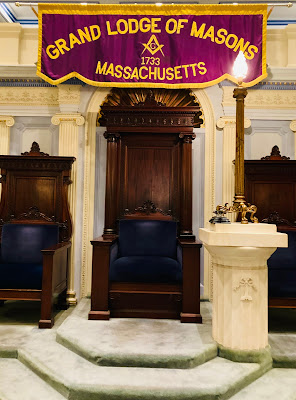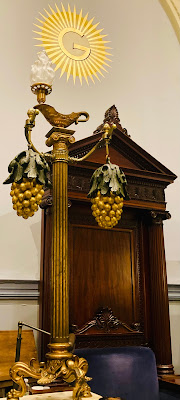Among the myths and legends that add flavor to Masonic history is the claim that Freemasons executed the attack on the East India Company’s ship at Boston Harbor December 16, 1773, when the cargo of 342 chests of tea was chucked into the water. I think it is more accurate and reasonable to say there were Freemasons involved, as some circumstantial evidence suggests that, but the caper was more complicated. (See A Retrospect of the Boston Tea Party, with a Memoir of George R.T. Hewes, a Survivor of the Little Band of Patriots who Downed the Tea in Boston Harbour in 1773, printed in New York, 1834.)
Next month, on the semiquincentennial anniversary of the Boston Tea Party, the Grand Lodge of Massachusetts will host a weekend of events to commemorate that mostly peaceful flash of rebellion. From the publicity:
The Grand Lodge of Masons in Massachusetts has partnered with the Massachusetts Sons of the American Revolution and the Dr. Joseph Warren Foundation to commemorate the 250th anniversary of the Boston Tea Party.
From December 15-17, Freemasons and their families will be joining us from across the country, and we hope you will also. Fifty-four grand jurisdictions have been invited to join us.
Friday, December 15
(open to the public)
A Historic Tavern Tour has been created in collaboration with Revolution 250, an organization the Massachusetts Historical Society created to support the commemorative events leading up to 2026. Open to Freemasons, their families, and invited guests.
If visiting from another jurisdiction, attend St. John’s Lodge’s annual installation. St. John’s Lodge was chartered in 1733 and is the oldest lodge in the Western Hemisphere.
Saturday, December 16
(open to the public free of charge)
We will host a world-class symposium at the Grand Lodge beginning at 8:30 a.m. and ending at 5 p.m. Through the generosity of our event sponsors, we can provide the events to the public at no cost.
8:30-9:10—Dr. Brooke Barbier: “Radicalizing John Hancock: The Tea Act and the Boston Tea Party.”
9:15-10 a.m.—RW Bro. Walter Hunt: “Freemasonry Before the Revolution.”
10:15-11:20—Boston-Lafayette Lodge of Perfection performing Treason to the Crown.
11:30-12:15 p.m.—Dr. Jayne Triber: “Brother Revere: How Freemasonry Shaped Paul Revere’s Revolutionary Role”
12:15-1 p.m.—Lunch
1:30-2 p.m.—Dr. William Fowler: “A Fireside Chat with Famed Author Dr. Fowler.”
2-3 p.m.—J.L. Bell: “How Bostonians Learned to Talk about the Destruction of the Tea.”
3-4 p.m.—Dr. James Fichter: “Tea: Consumption, Politics, and Revolution, 1773-1776.”
4-5 p.m.—Dr. Ben Carp: “Teapot in a Tempest: The Boston Tea Party of 1773.”
There will be guided tours of the Grand Lodge from 9 a.m. to 5 p.m. on a first come, first served basis.
The Grand Lodge will also have several rare artifacts on display to view (Freemasons and their families).
There will also be opportunities to attend a group tour of a few local historic locations. The historic sites set prices for tours.
Following the symposium, Freemasons can join a procession with the Grand Master from the Grand Lodge to the Old South Meeting House, then to the Boston Tea Party Museum, retracing the steps of our forefathers 250 years ago. (Registration will be $10 per Brother and include a commemorative apron for the event.)
Sunday, December 17
(open to the public)
The Grand Chaplains will lead a non-denominational ecumenical service at the Grand Lodge at 10 a.m.
Following the service, there will be a celebratory brunch in the Grand Master’s Banquet Hall with the Massachusetts Sons of the American Revolution. Tickets will be $50 and limited to 150 people.
To purchase event merch, please visit here and order now. Purchases will not be available on the day of the event.






































































































